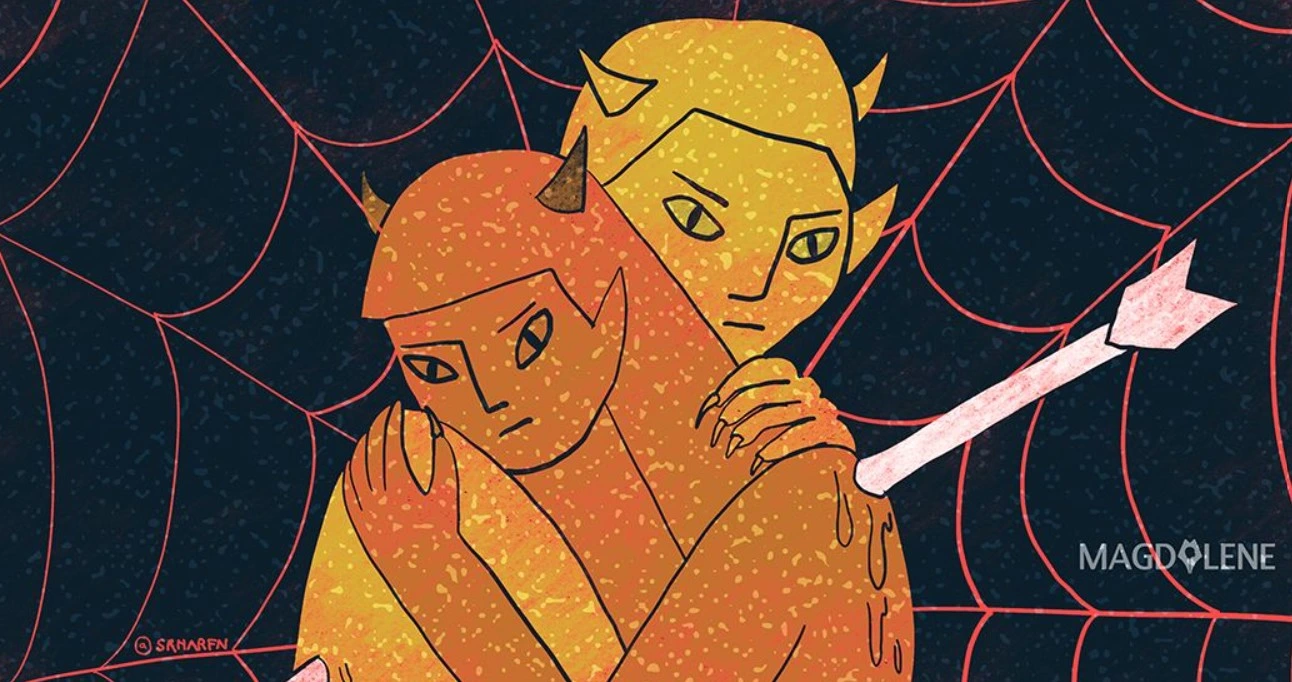Makeup for Men and Why Gender-Neutral Marketing is Important

“Aji” has been using facial wash since his university days, but for a long time he kept it a secret.
“I used to get embarrassed if people found out that I took care of my physical appearance, even if it was just using facial wash,” he says. It started in 2013, his first semester at the university.
“I started to set aside some money for facial wash, night cream, and lotion. My sister was the one who taught me about it. I just wanted to look clean and proper. I was going through transition from teen to adulthood, and the hormonal changes were affecting my skin,” he adds.
But he dreaded his friends finding out. The idea of men using beauty products and taking care of themselves had not been widely accepted then. He feared being seen as feminine. “I was afraid they would label a metrosexual, which had a negative connotation,” he says.
Radityo, a model and influencer, shares a similar story. “In my family I was the first guy who actually took care of his looks. Even if it was just choosing what to wear, I would put some thoughts into it. My family teased me about it and called me a metrosexual man,” he says.
Today the stereotype has started to shift, says Radit, who has over 60,000 followers on Instagram. “It’s called skin care – taking care of the skin – which does not exclusively belong to women or men,” he adds. “There’s nowhere that says if you don’t take care of yourself, then you’re masculine, and if you do, you’re metrosexual,” he adds.
In the past decade the shift is even more apparent, as beauty industry openly targets their new market: men.
If in the past, beauty products for men generally consist of shampoos, deodorant and shaving cream, now the range has expanded to include moisturisers, facial cleansers, concealers, eye serum, bronzer, and a multitude of skin care creams from anti-wrinkle cream, lightening lotion, to skin smoothing.
An investigation by Alexander Fury from The Independent found that in 2016 men’s beauty industry was valued at GBP14.8 billion. According to a projection by Statista, this industry would reach USD27.76 billion in 2023.
Fury states that the development of the industry has begun since 2013. He has seen a significant increase in men’s toiletry products that year: “2013 was the peak, it was the first year when men spent more on toiletries compared to shaving tools.”
The numbers attracted the attention of beauty brands. Major brands such as Estée Lauder, Clarins, and Kiehl’s have had a men-specific line for years. Other brands that usually focused more on women, followed in their footsteps. Dove introduced their men’s care line in 2010.
There’s no detailed data to reflect the phenomenon In Indonesia, but a survey conducted by Magdalene In June shows increased acceptance of men wearing makeup. Some 99.6 percent of 727 respondents, thought it was normal for men to use skin care, and 73.7 percent thought it was okay for men to wear makeup.
Respondent Rachmananda Adisurya says that the demand to wear cosmetics or use skin care is higher for men who live in big cities than those in smaller towns or in rural areas.
“For urban communities, I think it’s pretty normal. Urban communities will use something if they feel they need it – whatever the form of skin care may be, whether as simple as a facial wash or lotion. If they need it for their daily activities, then they will use it,” he says, adding people in rural areas have a different and more traditional concept of masculinity. In addition, those living in the urban areas also have the buying power, he says.
Also read: Why More Men Are Wearing Makeup Than Ever Before
Men’s Beauty Industry and Toxic Masculinity
Yet despite the growing acceptance of the use of skin care among men in the urban areas, the way the products are marketed are still reflective of the patriarchal values. Men’s beauty industry is often still trapped in gender marketing. Although men clearly buy and use body care products, most of them continue to perceive makeup and beauty in general as the domain of women.
“The key [in marketing] is to be undetected,” says Michele Probs, a makeup brand creator and makeup artist with a long list of clientele such as Barack Obama, John Travolta, and Kid Rock. Selling cosmetics to men requires a different method from selling them to women, she says. She notes that some of her male customers complained once about packaging that they deemed a bit too “girly.”
Probst overcame this issue by making sure their men cosmetics products are packaged in brown. She also gives masculine names for her products to make them more acceptable to the male users.
Cosmetics haven’t always been associated with women, but in the 20th century advertisement became gendered, capitalism quickly turned women into their target market. This was a progression from the industrial revolution that helped sealed the fate of men as breadwinners and women to take care of the home.
In a world where men are benefactors of patriarchy, many like Aji and Radit cannot use cosmetics products as freely as women, but this hasn’t always been the case. Over the course of history, men have been wearing beauty products, as can be traced to ancient Egyptian time. In the days of the Pharaohs, Egyptian men would feel confident when they applied eyeliner under their eyes. In modern times, only certain jobs involving cameras or stage presence require men to use cosmetics, from actors, TV personalities to politicians.
In the 1970s, when gothic and punk music grew as a protest against the establishment, band members who were mostly men put on makeup when they performed on stage.
“I started to grow my hair, wear make up, and other things because I was not allowed to do so in school,” said Robert Smith of The Cure in a 2004 interview with The Guardian.
Other rock and popstars with a penchant for makeup included David Bowie, Freddie Mercury, Steven Tyler and Boy George. Later, actors and musicians like Johnny Depp, Jared Leto and Brandon Flowers followed suit. Not all of them were gay men, a common presumption, like Freddie Mercury or Boy George. Today idols like Jefri Nichol, Juan (Big One), and Harry Styles embrace the concept that “fashion has no gender”.
Most of these men have been known as heterosexuals who rejected societal labels. They showed that makeup has nothing to do with sexual orientation. This would later grew into a discourse about queer baiting – a marketing technique that uses queer culture through trend and fashion.
According to the 2017 beauty industry trend analysis of Franchise Help, 75 percent of men did not use facial or skin care. But at the same time, the growth rate in the market continued to increase. Fung Global Retail Tech recorded the biggest growth in men’s body care industry in Western Europe and predicted the sector to reach US$14.4 billion in 2020. Rapid growth also occurred in Asia Pacific, including Indonesia.
South Korea, home to makeup wearing Kpop idols, is in the lead in Asia Pacific when it comes to men’s beauty industry. Globally it is placed in the the top 10 countries with the highest growth in men’s beauty industry. Euromonitor recorded that each Korean man on average spend US$39 a year to take care of their skin. This makes sense in a society that doesn’t judge men who take good care of their looks.
Joseph Grigsby, a marketing expert from Lab Series by Estée Lauder, notices an attitude change among the millennials and the younger generation. Those who are more open-minded than the previous generations have a more convergent views on masculinity and femininity. They are more acceptant of the women’s stronger social and public role, and they have a more progressive understanding of gender equality compared to the previous generations.
Grigsby sees a new culture brought forth by millennial men
“When it comes to women’s beauty, usually mothers would teach their daughters their beauty rituals. But men, at the most they are only taught how to shave. But now, millennials are teaching their fathers how to alleviate dry skin and get rid of under-eye bags,” Grigsby tells Racked.
Also read: In Defense of People Who Wear Makeup
The Rise of Gender-Neutral Marketing
In recent years, brands have come to realize the negative impact of gender-labelling their products and show intention to be more inclusive. Hence gender-neutral marketing.
Every year, profit from gender neutral products continues to grow. Pew Research data states 59 percent of Gen Z in the US demands beauty industry to produce makeup that’s not just for men or women.
Gender neutral marketing is important especially to help people understand that gender is a spectrum, instead of binary. These neutral brands have helped men who are closer to the feminine spectrum to feel safer in buying their products.
Queer activist and writer Jacob Tobia says, “The desire to have a gender-neutral space is not reckless. It is a deeper, more fundamental desire to feel safe and to be a part of this world.”
Jeje Bahri, an illustrator and media worker, shares this perception. For her, the journey to understand makeup is a journey to understand herself. “Makeup was a tool for me to feel more like ‘a woman’. The more feminine, the more beautiful, the more woman I was,” she says.
Makeup has helped her overcome gender dysphoria that she experienced throughout her teenage years. “Overtime, I realized that I didn’t feel that comfortable with [wearing] makeup – in the context of everyday use – because, aside from concerns about my skin condition, I feel like I’m lying to myself if I wear makeup too often or too thick,” She adds.
Jeje says our relations to makeup should not be toxic, especially not to the point of triggering body dysmorphia.
“I only use makeup and skin care to take care of myself. Whether it’s thick or thin, maximalist, or minimalist, that depends on who we are as a person. While we wait for our society to become more inclusive, maybe we can nudge the industry and brands to become more progressive,” Jeje says.
This journalistic project is supported by Meedan, a global technology not-for-profit that builds software and programmatic initiatives to strengthen journalism, digital literacy, and accessibility of information online and off.
Ilustrasi oleh: Karina Tungari
This is the English version of the original article
‘Makeup’ Juga Hak Laki-Laki: Alasan ‘Gender Neutral Marketing’ Penting
Read more articles from Beauty and Technology Series here:
Dysmorphia Filter: Catch-22 or Acceptable Progress?
Technology and Our Obsession with Beauty
How Influencers Alter The Face of Beauty Industry
Fair Skin, Pre-Colonialism Beauty Standard that Persists
Editor in Chief: Devi Asmarani
Managing Director: Purnama Ayu Rizky
Editor: Aulia Adam
Reporter/Researcher: Aurelia Gracia, Jasmine Floretta, Vania Evan, Theresia Amadea
Graphic Designer: Jeje Bahri
Camera and Editor: Tommy Trdkr
Web Developer: Denny Wibisono
Social Media: Siti Parhani
SEO Specialist: Kevin Seftian
Community Outreach: Paul Emas
Community Outreach Assistant: Tenny Maria
Digital Media Assistant: Chika Ramadhea
Data Analyst: Wan Ulfa Nur Zuhra (IDJN)






















